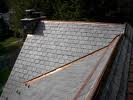Summer temperatures
causing house problems!
We market the services of independent Surveyors. Surveyors pride themselves on a high standard of work. We can offer Building Surveys also known as Structural Surveys and Home Buyers Reports. We also do Specific Defects also known as Engineers Reports or Damp Reports. We can also carry out Independent Valuations. Note these are not for bank lending but are to advise you how much we feel the property is really worth. If you have a property problem we may even already have written an article on it and we would refer you to the many articles we have on our website. All our independent surveyors are more than happy to chat to you about your property. Please Free Phone us on 0800 298 5424 and surveyor will call you back.
Free phone 0800 298 5424
Introduction
We are going to look at the temperature rise in summer and the effect that we find it has on residential properties and in particular their roofs walls and internal environments. We will consider in our experience the problems that can arise, which we have seen when carrying out surveys of properties due to heat in the summer.
Synopsis
We are going to look specifically at the problems and issues we have found with a summer affecting the structure of properties that we survey. We are also going to speak more widely about experiences we have had with snow more generally and also going to advise you of research if any which has been in this area, i.e. Learned Institutes or Bodies such as the Royal Institution of Chartered Surveyors, BRE (Building Research Establishment), we may even look at Wikipedia but we will not take it as gospel!
Construction Summary
To give you a flavour of the property that we are going to be considering, here is the construction summary.
External
| Chimneys: | Two brick chimneys |
| Main Roof: | Pitched roof with a slate roof covering |
| Gutters and Downpipes: | Original cast iron and plastic |
| Soil and Vent Pipe: | Plastic |
| Walls: | Flemish bond brickwork ( assumed) |
| External Joinery: | Sliding sash windows.
|
| Foundations: | Not inspected and known. |
As mentioned we are going to look at rain, we relate it back to a specific example that we have surveyed recently when someone was looking to purchase a property. This will show you just how important we think it is to have a building survey carried out.
We have used the term 'assumed' as we have not opened up the structure.
Executive Summary
Executive summaries are always dangerous as they try and encapsulate relatively complex problems in a few precise and succinct words. Having said that here is our executive summary and recommendations:
For those short of time, just like we have in our building surveys we have an Executive Summary here which identifies the main issues with a brief explanation.
What is the background to summer?
Summer is the warmest season of the year it comes from the Northern hemisphere and extends from March season to the autumn. The reason we have summer is because the Earth is titled in its position on path around the Sun. This means that for a certain number of months the Earths surfaces becomes more directly exposed the Sun and days become longer and nights shorter.
Recently due to climate change there is increased consensus that we are experiencing greater hot spells and warmer weather in the Summer, for example in 1996 the Summer has below 23% average rainfall, 1% above average sunshine and 10% above average temperature .Met office (2010) ARC fact sheet (2010). Average temperature is likely to increase until 2050 (BBC news 2010)
The increased temperatures in summer have implications for buildings and their structures. This results in some cases implications for costs of repair and insurance premiums since many householders are forced to make insurance claims for solving movement of buildings.
If you require any further help on changing summers please visit the following sites weather.org.uk, metcheck.com, news.bbc.co.uk/ weather.
One of the main problems for buildings is that high temperatures are that soils are affected by more temperatures. They hold water and when this dries out due to more heat it means more implications for our buildings.
Summer What does it mean to residential buildings?
One of the key implications of a dryer summer is that the higher level surfaces of a building such as roof coverings that is slate covered for example may be black in colour which absorbs radiation from the sun more readily due to its dark colour. We have noticed some of these coverings are tarred to stop rainwater penetration which helps absorbs more heat. The heat can store and build up in roofs, causing eventual condensation and implications for timbers inside. Acu Weather 2010
Secondly, when the walls of a building absorb heat and via radiation conduct this heat inside a building, it can lead to health effects for occupants because moisture builds up creating mould and condensation on wall surfaces which causes respiratory problems. Heat obviously means that more coolness is needed inside and this can lead to the use of air conditioning which also has more negative health impacts!
If heat accumulates around a building it can lead to thermal expansion of materials that are used. For example brickwork of walls and timber of windows expands and therefore deteriorates. If movements are not accommodated the building can start to crack and start to move in different places.
Dryer summers and heat affects the soil conditions. In London we typically have shrinkable clay upon which houses sit. Soil holds moisture when this starts to disappear it leads to more movement and subsidence causing movement in buildings particularly in older buildings which have shallow foundations. People that live in properties are forced to make insurance claims that are costly.
Defects we have seen while surveying properties
Typical of the buildings we Survey in summer and what we have seen...

Summer Tarring on roofs

Mould inside properties.

Building with shallow foundations experiencing subsidence
We witness roofs that are high pitched or very steep on which we can see tarring on roofs and inside very warm roofs that are experiencing condensation as a result.
How to solve these problems
In our experience, the problems of Summer that do occur have never been severe enough for us to recommend that roof tiles are completely replaced! Indeed one roof we looked at could use preventative measures during the Summer rather than repair or replacement. Certainly this is far better than the proposal to use alternative roof tiles.
The biggest problems surrounding Summer is the effect it has on Shrinkable clay particularly in the London area. This leads to subsidence and insurance claims in respect of building movement signalled by cracks within and externally. We have found Underpinning is one way of overcoming extensive movement a popular method during the 1970's! However our Surveyors are competent in advising on greater cost saving measures.
Time Line: A brief history of dryer summers have affected residential houses
| Prior to 1960's | Movement largely accepted in buildings |
| 1960's | Tarring used extensively to cover slate roofs |
| 1970's | Change in insurance policies greater subsidence claims and underpinning methods |
| 1980's | Surveys show errors in Underpinning |
| 1990's | Surveys still show subsidence an issue in London |
Inspection
We would carry out two different types of inspection in the summer on roofs and other parts of the building. Firstly, we would do a visual inspection both externally and internally. Secondly, we could check with a damp meter to establish the condition of the timbers inside the roof. This is really where wet rot occurs caused by the moisture of the summers. We can also check for moisture in joists using thermal imaging and or a similar damp test. We would also carry out a visual check for problems with soil foundations and humidity test for condensation inside homes.
Survey Findings
The sort of things we have found when looking at damage caused by summer is:
Summer temperatures lead to thermal expansion and differential movement in buildings where there have been extensions built, forcing cracks to appear inside buildings.
The problem of Shrinkable clay in London being affected by shrinkage caused by dryness in the soil in turn creating movement in buildings with shallow foundations. Furthermore cracks can lead to moisture entering inside wall constructions of buildings.
The problem of inside occupants of buildings being affected by rising moisture vapour in the air which spreads to colder surfaces such as walls causing mould and respiratory problems for them.
Summary Upon Reflection
A few final thoughts on the effect of summer temperatures and hot spells.
If you do carry out an inspection yourself do remember that the heat can make inspection very difficult and dangerous to enter voids in floors and upper areas of buildings. It is virtually impossible to tell of these kinds of matters from ground levels. You also need to look at other problems that could occur in the timber after the summer passes such a dry rot in timbers and this will require extensive monitoring afterwards.
Independent Surveyors
If you truly do want an independent expert opinion from a surveyor with regard to valuations, mortgages, mortgage companies, surveys, building surveys, structural reports, engineers reports, specific defects report, structural surveys, home buyers reports or any other property matters please contact 0800 298 5424 for a surveyor to give you a call back.
Commercial Property
If you have a commercial property, whether it is freehold or leasehold then sooner or later you may get involved with dilapidation claims. You may wish to look at our Dilapidations Website at www.DilapsHelp.com and for Disputes go to our Disputes Help site www.DisputesHelp.com
We hope you found the article of use and if you have any experiences that you feel should be added to this article that would benefit others, or you feel that some of the information that we have put is wrong then please do not hesitate to contact us (we are only human).
The contents of the website are for general information only and are not intended to be relied upon for specific or general decisions. Appropriate independent professional advice should be paid for before making such a decision.
All rights are reserved the contents of the website are not to be reproduced or transmitted in any form in whole or part without the express written permission of www.1stAssociated.co.uk

